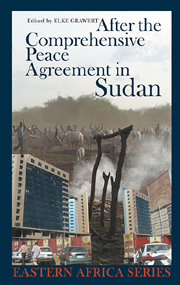Book contents
- Frontmatter
- Contents
- List of Tables & Figures
- Editor's Preface
- Notes on Contributors
- List of Acronyms
- Map of Sudan
- 1 Introduction
- I Implementation & Potential of the CPA
- II Challenges Facing Post-war Societies in Sudan
- 5 The CPA & Beyond
- 6 Ethnic Identity Politics & Boundary Making in Claiming Communal Land
- 7 Return Migration to the Nuba Mountains
- 8 Challenges of Basic Education in Southern Sudan
- 9 Abduction, Confinement & Sexual Violence against South Sudanese Women & Girls in Kakuma Refugee Camp, Kenya
- 10 Identity, Citizenship & Reintegration
- III The CPA in its Sub-regional Context
- IV Beyond the CPA
- Index
- EASTERN AFRICAN STUDIES
7 - Return Migration to the Nuba Mountains
from II - Challenges Facing Post-war Societies in Sudan
Published online by Cambridge University Press: 05 April 2013
- Frontmatter
- Contents
- List of Tables & Figures
- Editor's Preface
- Notes on Contributors
- List of Acronyms
- Map of Sudan
- 1 Introduction
- I Implementation & Potential of the CPA
- II Challenges Facing Post-war Societies in Sudan
- 5 The CPA & Beyond
- 6 Ethnic Identity Politics & Boundary Making in Claiming Communal Land
- 7 Return Migration to the Nuba Mountains
- 8 Challenges of Basic Education in Southern Sudan
- 9 Abduction, Confinement & Sexual Violence against South Sudanese Women & Girls in Kakuma Refugee Camp, Kenya
- 10 Identity, Citizenship & Reintegration
- III The CPA in its Sub-regional Context
- IV Beyond the CPA
- Index
- EASTERN AFRICAN STUDIES
Summary
Introduction
Internally displaced persons (IDPs) are defined as people who have been forced by certain disastrous factors to move without prior arrangements and under very difficult and risky conditions while seeking refuge and protection. This involuntary internal displacement may result from civil wars or from ecologically related disasters such as famine, drought, desertification, floods and earthquakes (Komey 2003: 60). Thus, IDP are individuals or groups of people who have been forced or obliged to flee or to leave their homes or places of habitual residence in order to avoid the effects of armed conflict, gross violations of human rights or natural/human-caused disasters without crossing an internationally recognised state border (Bascom 1993: 33; IDMC 2006).
In this respect, Sudan is no exception since it has been in a state of civil war for more than forty of its fifty-four years of independence. Though various factors contributed in a varying degree to the population displacement in Sudan, civil war remains the single key contributing factor. Throughout the post-colonial era, Sudan has experienced large population movements and displacement because of ecological deterioration and regional disparities in development. The UN estimates that conflicts and drought have left 6.7 million Sudanese displaced, including some 550,000 refugees in neighbouring countries or beyond (Malik 2005: 31). However, the persistent pattern of political instability, coupled with prolonged civil wars in southern Sudan, the Nuba Mountains, southern Blue Nile, and Darfur, is the main dynamic that has resulted in immense waves of IDPs (Pantuliano 2007).
- Type
- Chapter
- Information
- After the Comprehensive Peace Agreement in Sudan , pp. 130 - 140Publisher: Boydell & BrewerPrint publication year: 2010

